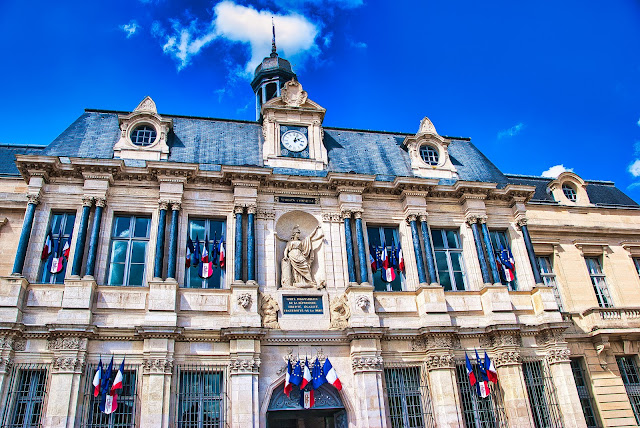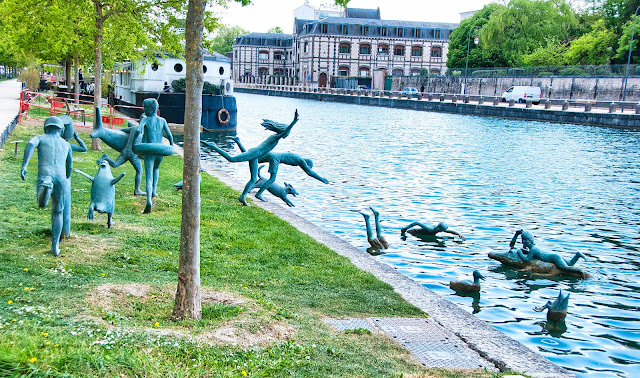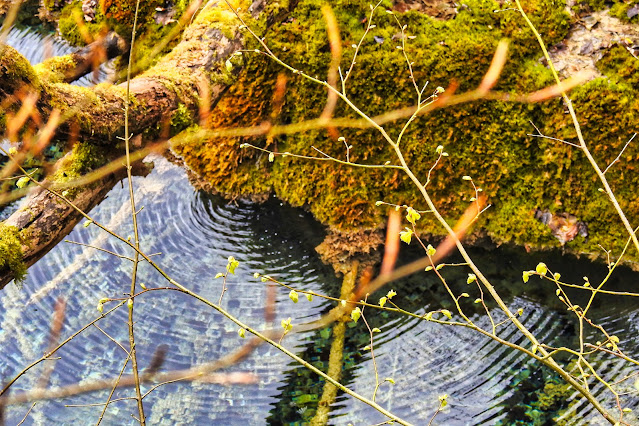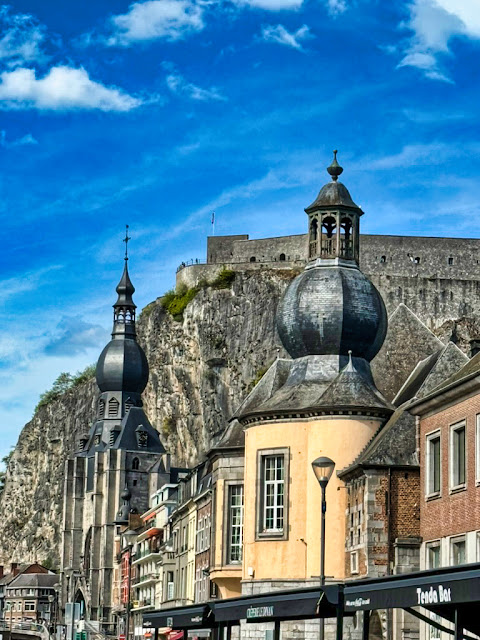And now on the Road to Belgium
Up until this point we have been using public transportation, but now it was time to pick up our leased car at Charles de Gaulle. We used this leasing company, distinct from a rental company, several times and have always been very pleased with it. You need to lease a car for 21 days or more but, for an unbelievably low price, you get a brand new car, full insurance and, theoretically, full roadside assistance. We got the car with no problem and after a brief tutorial on all of its numerous advanced safety features and gimmicks, we set off.
Our next stop was Ghent in Belgium, where we spent three nights in a very unique place. It was actually an amazing place! It was an old monastery and part of the monastery included a separate small house, called the Vault. Michael will include a couple of pictures of it. It was very unique in that it had its own chapel, complete with choir balcony attached to the living room. The whole monastery dated back to the 1400s and featured a huge building. In a addition to the Vault, there were large grounds, which is most unusual for something located in the center of the city.
 |
| The exterior of the "Vault"... |
 |
| and a picture of the chapel from the choir loft. |
 |
| The monastery... |
 |
| and some of the grounds, which we enjoyed during our stay. |
Both Ghent and Brugge (which we would visit the following day) are cities with canals. Both are very rich in architecture and art, and both cities were very vibrant trading cities for centuries. In Ghent we simply wandered the streets and took in the various squares and walkways next to the scenic cities canals, as well as the interesting architecture of the old, medieval buildings. We always like to get on the water in cities where that is possible because it gives you such a different perspective on the buildings and the layout of the city.
 |
| Ghent is famous for its canals... |
 |
| as can be seen in these two photos. |
 |
| The best part about travel is serendipity. We came across this bride and groom as they arrived at the church. We saw many of these bikes in Belgium with the large baskets up front. The groom delivered the bride in this. |
 |
| It was still very cool so the bride arrived with a jacket and scarf over her wedding dress. |
 |
| Here are the groom and bride. The bride has now shed her jacket and scarf, but the groom is still wearing his helmet. |
 |
| This is a photo of St. Bavo's Cathedral, an impressive Gothic cathedral built on the ruins of a 12th century Romanesque church. Charles V was baptized here in 1500. The Ghent belfry is in the background on the left and the kneeling figures sculpture is in the foreground. |
 |
| This impressive building is the Old Post Office with the Ghent Belfry behind it. |
 |
| These ornamental copper statues are on the 16th century Mason's Guildhall. |
 |
| This shows the top portion of the Ghent belfry, which is inscribed upon the World Heritage List of UNESCO. The 14th century belfry originally stood on its own, but later it is incorporated in the complex of the 15th century Cloth Hall and the 18th century town prison or 'Mammelokker'. This name is derived from the legend of Cimon who was condemned to death by starvation. He was saved by his daughter who allowed him to suck ('lokken') some milk from her breast ('mamme') every day. |
 |
| The "Narcissus fountain", as it was called by Karel van de Woestijne, was originally a plaster model created by the sculptor George Minne in 1898. The five identical youths on the fountain were cast in the 1930's in an Art Deco style. |
 |
| The clock on the Ghent Belfry. Note the two visible figures on the corners known as the famous 'Men from Ghent', the stone watchmen. The heavily guarded tower still preserves the civic privileges which Ghent received in 1180. |
 |
| One of the stone watchman in greater detail. |
 |
| Guilded crockets and the famous dragon-shaped weather vane decorate the elegant spire. |
 |
| The altar inside St. Bavo's Cathedral, which houses an impressive number of art treasures, the baroque high altar in white, black and red flamed marble among them. |
 |
| One of the many art items on display,... |
 |
| along with this painting by Theodor Rombouts. |
 |
| This statue of St. Damien, a Belgian priest, who attended to the needs of the leper colony on Molokai in Hawaii from 1873 until his death in 1889. |
Ghent is the size city we love to visit. Its current population is about 200,000 and that is big enough to provide a vibrant city core while being small enough to negotiate on foot (particularly if you stick to the older, more interesting parts of the city). After lunch we went down to a canal and bought tickets for a boat ride. We needed to wait for a while for the next scheduled boat, so we propped ourselves on some chairs staring out at the water and zoned out. Along the canal on both sides were flag poles displaying flags of various nations - probably 10 or 15 flags. As we were sitting contentedly and well fed, we heard a man screaming "No more American flags, no American flags!" very loudly and very often. This was the first time ever in Europe that we had encountered any anti-American sentiment. Oh sure, we had experienced some arrogant, annoyed Parisians in our time, but it was always personal and was never about our country. It's rather unsettling to think that we seem to be alienating the very people who, for decades, we've regarded as our closest allies. Hopefully we're not going to encounter more of this sentiment as we wander our way through France.
 |
| Two swans facing in opposite directions, whose significance will be explained by Deirdre below. |
 |
| The facades of some of the Ghent buildings were extraordinary,... |
 |
| as can be seen from these two photos. |
 |
| This trompe l'oeil was painted for the movie "The Monument Men", and was left on the side of this building. |
 |
| It would be great to have something like this on Lake Chapala where I kayak. |
 |
| This interesting bar had 500 different Belgian beers on offer (out of the 800 different Belgian beers brewed). Among the aptly named beers was Delirium Tremens. We only sampled one each of the 500 beers on offer. |
 |
| We also learned that for each type of beer there is a different glass, and no self respecting Belgian would ever accept a beer in the wrong glass. |
The predominant industry in Ghent at one time revolved around the textile trade. During the Industrial Revolution an inhabitant of Ghent, Lieven Bauwens, took it upon himself to go to Manchester, England, where the famous spinning jennies resided. This Industrial Revolution technology revolutionized cloth production and Bauwens wanted to bring this machine to Ghent. In an early form of industrial espionage, Bauwens took a spinning jenny, dismantled it and put the parts in coffee and sugar containers and shipped the parts back to Belgium. Ghent soon became the Manchester of Belgium.
Bruges, beautiful Bruges
After our first day we moved on to Bruges, which is only about 45 minutes from Ghent. If Ghent were a picture postcard, Bruges was beyond description. It's roughly half the size of Ghent, but it seems as if its old town is of a comparable size. The town has an astonishing number of churches. At one point we were told when there were 20,000 people inhabiting Bruges, there were 20 churches, which seems a little excessive to me.
 |
| The top of one of the entrances to the city. |
 |
| One of the twenty churches in Bruges. |
 |
| The Virgin Mary adorns many of the houses in Bruges. This one shows the Virgin with Jesus as a babe,... |
 |
| and this larger one shows the Virgin with Jesus as an older child. |
 |
| The mascot of Bruges is the bear. |
Bruges is also known for its swans. Everywhere you go on the water you will see pairs of swans and we were there for nesting season. When we took a boat trip on the canal, our guide pointed out several nesting couples, and said that the city was extremely protective of the swans to the point of feeding them and providing veterinary care. Wherever you went you would see an emblem of two swans with their beaks touching and with their necks arched. The emblem resembles a heart and signals eternal and loyal love (Since swans mate for life, they are an appropriate symbol for this.) However our guide pointed out when you see an emblem where the swans are facing in opposite directions, this meant the establishment was a whore house. Travel is so educational.
 |
| One of the Bruges buildings with each successive story jutting out a little further to prevent the rats from reaching the upper stories, where the grain was stored. |
 |
| One of the many Bruges swans we encountered on our boat trip on the canal. |
 |
| Bruges even has sculptures dedicated to the swan. |
 |
| The entrance to the old St. John's Hospital founded in the mid 12th century. It was a place where sick travelers and pilgrims would receive care. |
Once on the boat the dialogue coming from our tour leader was really very fascinating. Among the things he told us was the fact that many of the houses are painted an ox blood red. The reason for this is that apparently rats hate ox blood red. Now since Bruges was a major grain merchant city, and the fact it was filled with water made rats a significant problem for Bruges. So in their never ending battle to combat the rats they had several secret weapons. The first was the color they painted their houses. The second was on the facade of the houses. Every six or eight feet the shingles would jut out about six inches from the bottom to the top until it reached the gable and the roof of the house. Rats can't negotiate the overhangs, so this kept the rats down at water level. The other advantage of this architectural feature was that with each floor you gained a little more square footage. Since you were taxed on the square footage of the first floor, it was a very clever way to avoid more taxes.
On our travels through Bruges we visited a beguinage. This was a really fascinating social construct that was started in the Middle Ages. Wealthy benefactors contributed to the construction of a small community within the city which was intended to house widows or single women of little means. While religious orders oversaw the beguinage, the inhabitants were not required to become part of the religious organization, did not take orders or adhere to any particular religious belief. There are no more beguines living here, but since 1927 it has functioned as a convent for Benedictines.
 |
| The entrance to the 'Princely Beguinage Ten Wijngaerde", which was founded in 1245. |
 |
| The white fronted house of the beguinage. |
 |
| This is known as the 'Lover's Bridge' over the canal. |
 |
| Quite a few swans and a few ducks were resting on the lawn. |
 |
| This horse trough was set up for the horses who draw the carriages. |
 |
| Holland isn't the only place to see tulips. Belgian farmers are now leasing their land for growing tulips, because Holland can no longer meet the demand. |
The food in Belgium is what I would truly call continental. It seems to take a little bit from everywhere. Of course, there are the Belgian waffles and the fries, but there's a strong French influence as well, with a smidgen of German as well in the more Eastern sections of the country. We ate very well the whole time we were in Belgium, perhaps too well. My stand out meal was mussels in Bruges which came heaping hot with a delicious sauce. But enough about food for now.
 |
| The Church of Our Lady is one of the many churches here. A chapel stood on this site before 900 CE. The church survived fires and was even publicly auctioned during the French Revolution. |
 |
| Throughout all of the chaos, the church continued to be a house of prayer and a final resting place for several prominent citizens of Bruges. |
 |
| The confessionals in the church featured these most beautiful baroque sculptures in Bruges. |
 |
| The various figures were Vice, St. Jerome, St. Augustine, Faith, St. John, Virgin and Child with St. Anne and St. Peter. |
 |
| This colorful, painted memorial in half relief commemorated the Da Baenst family. This shows the deceased, together with their patron saint and children, kneeling around the enthroned Madonna, begging her to plead with God for their salvation. |
 |
| The Blessed Sacrament Chapel was built in the mid 19th century by the architect Jean-Baptiste de Bethune in the English style. The consecrated hosts for communion were stored in this chapel. |
 |
| Around 1270 it became customary to paint the inside of brick lined graves. |
The Virgin and Child are usually depicted at the foot end, as seen here.  |
| Charles the Bold, the Duke of Burgundy, died at Nancy in 1477 and was finally laid to rest here in 1563 in this tomb in the chancel of the church. |
 |
| After falling from her horse, Mary of Burgundy died on March 27, 1482 at the Prinsehof, the Duke's Palace, in Bruges. She was just 25 years old, but had ruled the Low Countries since the death of her father, Charles the Bold. |
 |
| This marble sculpture of the Madonna and Child by Michelangelo is the only sculpture of his outside of Italy. |
Welcome to Wuppertal
Our next stop was going to be a brief foray into Germany. I know that sounds far, but it is only 3 1/4 hours from Ghent to Wuppertal, Germany, where the last au pair to take care of our sons has been living since her return to Germany over 30 years ago. We have seen a number of our au pairs over the years. However Maren and her family live in an area that just always seemed a little bit too far and inaccessible on our previous trips. So when we realized we were going to be within striking distance, we immediately got in touch with Maren and arranged for a meet up at dinner.
It was a wonderful evening. Of course we had never met Maren's husband or her two children, and we spent hours catching up on everything that had happened since we last saw Maren, which was clearly a lot. Both Maren's son and daughter speak excellent English. Matilda, the young daughter, was so excited to use her English, and we were so excited to watch her enjoying it. It was hard to believe that Maren was only a couple of years older than her son when she came to live with us in the United States. We were very fortunate to not only have such great au pairs, but also to be able to stay in touch with so many of them over all these years. The visit was too short with Maren and her gang, but we made them promise that they would come see us in Mexico, and hopefully they'll take us up on that offer in the near future.
 |
| Deirdre with Maren and her family, taken after our dinner with them in Wuppertal. |
 o
o


































































































